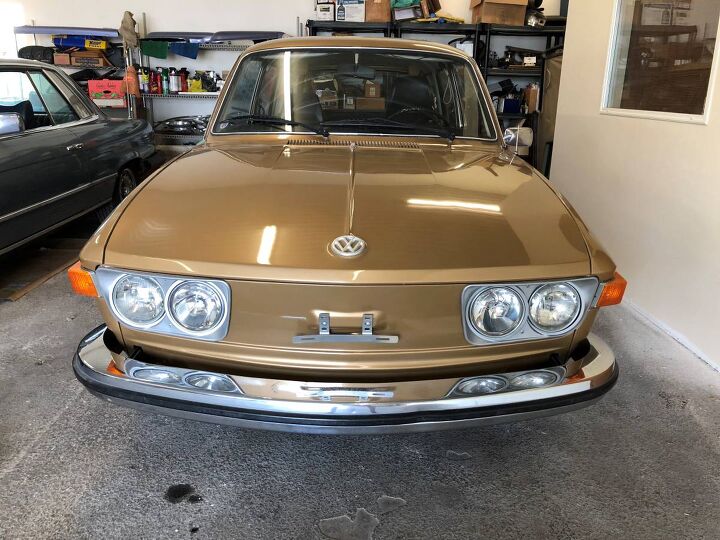Rare Rides: A Rear-engined Volkswagen 412 Wagon From 1973

Air-cooled engine at the back, two upright, circular headlamps at the front, and classic gold metallic paint.
It’s not a vintage Porsche 911, but it is a cousin — a Volkswagen 412 from 1973.
Volkswagen’s Type 4 was a brand new type of car for the company. It was the first time VW offered any family car with four doors. It also introduced a more modern type of build to Volkswagen customers, as it was of true unibody construction. Other advancements included coil springs, a manual transmission with a hydraulic clutch, and a suspension featuring MacPherson struts up front and trailing wishbones at the back.
This was no basic compact — all Type 4 cars had no-charge metallic paint, radial tires, and undercoating. Inside was full carpeting, a clock, rear window defrost, and an auxiliary heating system (via a gas-operated unit with its own spark plug).
The Type 4 hit dealers in 1968, labeled on the outside as the 411. Considered a midsize family car at that time, two- and four-door sedans were available, as well as a three-door wagon. Though successful elsewhere, the 411 was not imported to North America until 1971, near the end of its life.
1972 saw the introduction of a second-generation Type 4, the 412. The new version had revised headlamps on a new front end, and that was the extent of exterior changes. At the rear, engine changes in 1974 upped the displacement from 1679cc to 1795cc, with both engines being of flat-four layout. Transmission options included a four-speed manual or the three-speed automatic in today’s golden example.
As 1974 drew to a close, Volkswagen had a newer, water-cooled sedan ready as the Type 4’s replacement. Americans called it Dasher, and the rest of the world knew it as Passat. A successful global model, Volkswagen shifted over 367,000 Type 4s over six model years. Of those, about 117,000 were sold in the United States. But that was a very long time ago.
Today’s Rare Ride is located near Madison, Wisconsin, which is south of the Canadian province of Ontario. It needs a few odds and ends, especially where the interior is concerned, but comes with a couple boxes of spare parts.
It’s yours for $6,900.
[Images: seller]

Interested in lots of cars and their various historical contexts. Started writing articles for TTAC in late 2016, when my first posts were QOTDs. From there I started a few new series like Rare Rides, Buy/Drive/Burn, Abandoned History, and most recently Rare Rides Icons. Operating from a home base in Cincinnati, Ohio, a relative auto journalist dead zone. Many of my articles are prompted by something I'll see on social media that sparks my interest and causes me to research. Finding articles and information from the early days of the internet and beyond that covers the little details lost to time: trim packages, color and wheel choices, interior fabrics. Beyond those, I'm fascinated by automotive industry experiments, both failures and successes. Lately I've taken an interest in AI, and generating "what if" type images for car models long dead. Reincarnating a modern Toyota Paseo, Lincoln Mark IX, or Isuzu Trooper through a text prompt is fun. Fun to post them on Twitter too, and watch people overreact. To that end, the social media I use most is Twitter, @CoreyLewis86. I also contribute pieces for Forbes Wheels and Forbes Home.
More by Corey Lewis
Latest Car Reviews
Read moreLatest Product Reviews
Read moreRecent Comments
- ToolGuy I am slashing my food budget by 1%.
- ToolGuy TG grows skeptical about his government protecting him from bad decisions.
- Calrson Fan Jeff - Agree with what you said. I think currently an EV pick-up could work in a commercial/fleet application. As someone on this site stated, w/current tech. battery vehicles just do not scale well. EBFlex - No one wanted to hate the Cyber Truck more than me but I can't ignore all the new technology and innovative thinking that went into it. There is a lot I like about it. GM, Ford & Ram should incorporate some it's design cues into their ICE trucks.
- Michael S6 Very confusing if the move is permanent or temporary.
- Jrhurren Worked in Detroit 18 years, live 20 minutes away. Ren Cen is a gem, but a very terrible design inside. I’m surprised GM stuck it out as long as they did there.








































Comments
Join the conversation
Yes, the brakes were essentially the same as the Type III. With the extra weight of the 411 they wore out rapidly. That was one of the changes on the 412. The rotors got thicker and the pads thicker and bigger. Since the front suspension was very similar to the Super Beetle installing the disc brakes on the Beetle was a popular, if expensive idea. People also retro-fitted the larger 412 brakes onto disc brake Ghia and Type IIIs.
Around this time our neighbor across the street had a 411 wagon (along with a '73 Chevy C-20 pickup, that they used with a slide-in camper). The thing I remember most about their 411 was the lopey idle, courtesy of the Bosch D-Jet fuel injection and its "electronic brain" (a phrase used in a Hot Rod magazine article at the time).